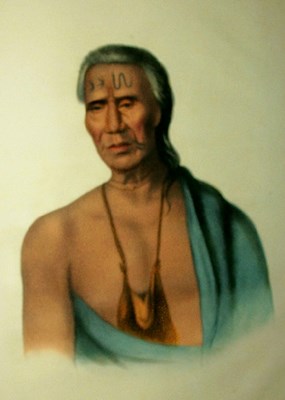
The area where Anne Hutchinson fled to escape the Puritans, today's northeastern Bronx and southern Westchester County, had long been the ancestral home to various bands of native peoples. They were part of the broader group of Lenape or Delaware Indians, and spoke a tongue belonging to the Algonquian language family. They have often been mistakenly referred to as "Siwanoy," a name they almost certainly never called themselves but which nonetheless has become deeply entrenched in our literature. Sometimes scholars also call them "Munsee" -- after the name of the Lenape dialect they spoke. However, like other native groups, they tended to call themselves by the names of their local villages. The Lenape were semi-sedentary and peaceful, having settled in their homeland no later than 1,000 years ago and probably much earlier than that. Indeed, archaeologists tell us that people were living in the northeast for at least 12,000 years but with the absence of ancient writings there is no way of knowing what these earlier groups called themselves. The Lenape that met Anne Hutchinson were clustered along the Long Island Sound and its inland rivers from today's Westchester County to the Bronx. The Lenape enjoyed a traditional and stable lifestyle in established villages, subsisting through hunting, fishing, gathering, and horticulture, although their lives were periodically interrupted by limited warfare with other regional Indian groups. A village generally comprised a cluster of several wigwams -- round or oval shaped bark dwellings with an aperture in the roof serving as a chimney. Some could be as long as 60 feet and hold several families. Since they lived along the waterfront, the diet of these Lenape groups was dominated by shellfish. Mussels, clams and oysters were dug from the beaches and shores on a daily basis. The Lenape also refashioned elements of the shells to create beaded belts known as wampum, a highly valued commodity. The large nets crafted by Lenape to catch spawning fish -- alewives, shad, sturgeon and other species -- were weighed down with stones and spread across the mouths of streams, yielding a considerable harvest each spring. The Lenape supplemented their diet with flesh cut from deer and elk felled with finely sharpened, triangular stone arrows. (An Indian hunting party in 1643 initially discovered the Hutchinson homestead.) Deerskin was also the principal material for clothing. Several times a year the Lenape burned sections of the woods in order to maintain the meadows and habitats upon which the herds of game animals depended. Women were responsible for most of the agriculture, growing primarily corn, beans and squash, and also gathering nuts and berries from the fertile local forests. In a society where heredity was determined through the female line, women enjoyed considerable respect. A Lenape leader, often referred to as a sakima (the word sachem comes from a related Algonquian language) was recognized, but they lacked the coercive powers of government enjoyed by most European rulers; instead, he had to persuade other band members to follow his policies, leading to a perhaps more democratic society. A sakima had many tasks: exercising ceremonial duties, settling minor disputes and managing relations with other tribes, and eventually also with Europeans. Village members could reject or reverse previous directives, a pattern which had important consequences in the early 1640s with Dutch claims to the area where Anne settled. In what emerged as an important source of misunderstanding with the Dutch, and indeed with most European settlers in the New World, the Lenape recognized land as the communal property of the village. Land could be parceled out to a family; it could be re-distributed to another clan as necessary and required, and individuals and groups could enjoy use rights on it. However, the Indians had no understanding of individual private property during the time when the first European settlers were arriving in America. When war was declared, a special group of men recognized for bravery and martial skill led the band. These war captains temporarily superseded the sakima and his council, making military decisions which could also include crafting peace terms. Tragically, just as Anne Hutchinson arrived in our area, this system of war chiefs was activated. The Lenape way of life, which had sustained the local bands for hundreds of years, would ultimately be compromised by the intrusion of the Europeans on the landscape. In the 1640s, these changes were beginning to become manifest when war erupted between the New Netherland colony and the Lenape, and Anne and her party settled in the area. |
Last updated: March 31, 2012
